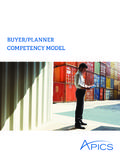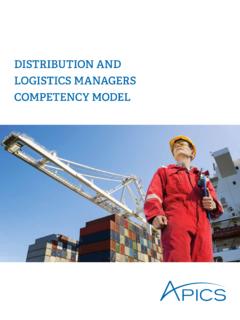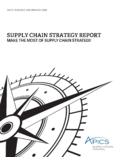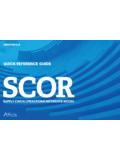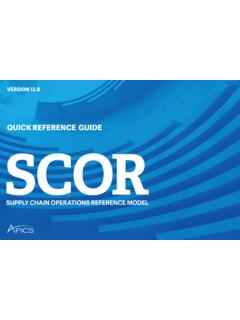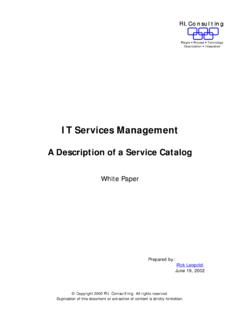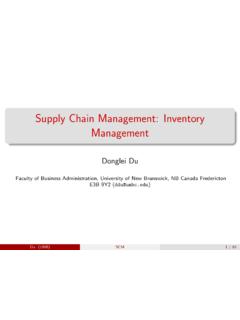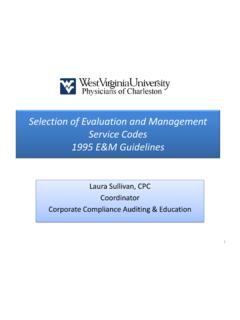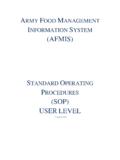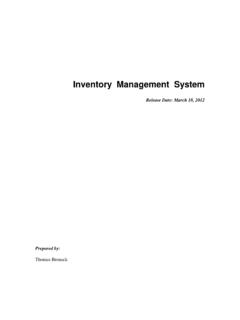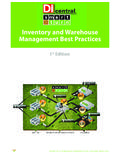Transcription of PRODUCTION AND INVENTORY MANAGEMENT …
1 PRODUCTION AND INVENTORY MANAGEMENT JOURNALVOLUME 49, NO. 1 2014A Conceptual Framework for INVENTORY MANAGEMENT : Focusing on Low-Consumption ItemsPeter WankeIntegrating FMEA with the Supply Chain Risk MANAGEMENT Processes to Facilitate Supply Chain Design Rao Tummala, Tobias Schoenherr, CSCP, Thomas HarrisonOperations MANAGEMENT Salary ReportL. Drew Rosen, Thomas Janicki, Judith GebauerA Tutorial on Managerial Cost Accounting: Year-End ReportingTimothy D. Fry, Kirk D. FiedlerPRODUCTION AND INVENTORY MANAGEMENT JOURNAL2 ABOUT THE PRODUCTION AND INVENTORY MANAGEMENT JOURNALT hrough the support of APICS Foundation, the P&IM journal is committed to being the premier outlet for managerial-focused research in operations and supply chain MANAGEMENT .
2 The APICS Foundation 2014 board officers and members are:President: Karl Klaesius, CPIM, KS&E Enterprises Vice President: Shari Ruelas, CPIM, CSCP, Chevron ProductsTreasurer: Robert Vokurka, PhD, CPIM, CIRM, CSCPB arbara Flynn, PhD, Richard M. and Myra Louise Buskirk Professor of Manufacturing MANAGEMENT , Kelley School of Business, Indiana UniversityAlan Dunn, CPIM, GDI Consulting and Training Company Katie Fowler, Schlumberger Antonio Galvao, CSCP, Sealed Air Inc.
3 Michael Wasson, CSCP, Coca-Cola North America Paul Pittman, PhD, Indiana University SoutheastMarco Ugarte, PhD, CPIM, CSCP, MillerCoorsTABLE OF CONTENTSPRODUCTION AND INVENTORY MANAGEMENT JOURNALA rticlesA Conceptual Framework for INVENTORY MANAGEMENT : Focusing on Low-Consumption Items by Peter WankeIntegrating FMEA with the Supply Chain Risk MANAGEMENT Processes to Facilitate Supply Chain Design Decisionsby Rao Tummala, Tobias Schoenherr, CSCP and Thomas HarrisonOperations MANAGEMENT Salary Reportby L.
4 Drew Rosen, Thomas Janicki, Judith GebauerA Tutorial on Managerial Cost Accounting: Year-End Reportingby Timothy D. Fry, Kirk D. FiedlerEditorial Staff InformationRobert L. BregmanEditor in ChiefAssociate Professor Decision and Information Sciences Department University of 24 7183 PRODUCTION AND INVENTORY MANAGEMENT JOURNAL4 ARTICLE SUMMARIESA CONCEPTUAL FRAMEWORK FOR INVENTORY MANAGEMENT : FOCUSING ON LOW CONSUMPTIONThis article evaluates the premise of demand adherence to normal distribution in INVENTORY MANAGEMENT models, showing that this can lead to significant distortions, mainly to stock control of very low and low consumption items.
5 The article thus proposes a framework to help managers determine the best stock policy to be adopted given product demand characteristics. The article also presents the use of such a framework in a case study, in an attempt to illustrate the benefits of adopting probability density functions that are more adequate to product demand characteristics, in terms of total costs of stocks. INTEGRATING FMEA WITH THE SUPPLY CHAIN RISK MANAGEMENT PROCESS TO FACILITATE SUPPLY CHAIN DESIGN DECISIONS We present a novel approach of integrating failure mode and effect analysis (FMEA) with a supply chain risk MANAGEMENT process (SCRMP).
6 Focusing on the challenging task to assess and manage supply-side risks in global supply chains, the approach developed offers an effective and affordable way for firms to provide decision support for the selection of their most appropriate supply chain design. The aim of the integrated approach combining the strengths of FMEA and SCRMP is to gather as much pertinent information as possible, to structure it, and to comprehensively delineate all potential supply chain risk factors, offering valuable decision support. We illustrate the application of the approach at Michigan Ladder Company, where it was applied to two specific supply chains for the procurement of fiberglass ladders.
7 Specifically, one supply chain spanned from China to the via Mexico (taking advantage of a Mexican maquiladora), and one spanned from China directly to the The combination of FMEA and the SCRMP enhanced the manufacturer s confidence in its supply chain design decision, and enabled the firm to proactively manage its supply-side risks. Overall, the article is meant to motivate practitioners to embark on the journey of active risk MANAGEMENT . While some may perceive risk MANAGEMENT as a daunting task or being primarily employed by larger firms, we provide guidance for firms of any size to apply the approach it can be done, and does not have to consume an inordinate amount of resources.
8 OPERATIONS MANAGEMENT SALARY REPORT APICS, in conjunction with the Cameron School of Business at the University of North Carolina Wilmington, is pleased to provide the results of the 2013 Operations MANAGEMENT Salary Report. The data are collected from a random sample of more than 30,000 operations MANAGEMENT professionals worldwide. VOLUME 49, NO. 1 5 Twice annually, approximately fifty percent of the APICS membership and customer base receives a request to complete an online survey collecting data concerning current salary and compensation by job function and title.
9 The survey can be accessed at: TUTORIAL ON MANAGERIAL COST ACCOUNTING: YEAR-END REPORTINGB uilding on the companion article A Tutorial on Managerial Cost Accounting: Living with Variances by Fry and Fiedler (2011), this current paper picks up where the previous paper left off and illustrates how the MANAGEMENT accounting system (MCA) is linked to financial accounting (FA) to generate the year-end financial reports required by shareholders, banks, and the IRS. The prior paper focused on the detailed use of information provided by the MCA throughout the year and walked through the development of the yearly budget, calculation of product costs, determination of budget variances, derivation of the periodic income and statement of cash flows reports, and provides possible examples of dysfunctional behavior at a fictitious company called Mandrake Manufacturing.
10 This tutorial concentrates on the interaction of the MCA and FA systems and the PRODUCTION of year end FA statements. In addition to providing information such as cost of goods sold, INVENTORY values, and operating standards to the FA, the year-end information provided by the MCA is also used to develop next year s budgets. In this present paper, the conversion of the MCA reports into the FA reports will be presented. Also, the impact of the MCA reports on future budgets will be discussed. As pointed out in F&F, it is vital that operations managers understand how the accounting systems used by their company function.
